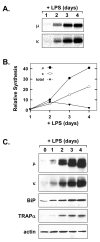The unfolded protein response of B-lymphocytes: PERK-independent development of antibody-secreting cells
- PMID: 17822768
- PMCID: PMC2677759
- DOI: 10.1016/j.molimm.2007.07.029
The unfolded protein response of B-lymphocytes: PERK-independent development of antibody-secreting cells
Abstract
When B-lymphocytes differentiate into plasma cells, immunoglobulin (Ig) heavy and light chain synthesis escalates and the entire secretory apparatus expands to support high-rate antibody secretion. These same events occur when murine B-cells are stimulated with lipopolysaccharide (LPS), providing an in vitro model in which to investigate the differentiation process. The unfolded protein response (UPR), a multi-pathway signaling response emanating from the endoplasmic reticulum (ER) membrane, allows cells to adapt to increasing demands on the protein folding capacity of the ER. As such, the UPR plays a pivotal role in the differentiation of antibody-secreting cells. Three specific stress sensors, IRE1, PERK/PEK and ATF6, are central to the recognition of ER stress and induction of the UPR. IRE1 triggers splicing of Xbp-1 mRNA, yielding a transcriptional activator of the UPR termed XBP-1(S), and activation of the IRE1/XBP-1 pathway has been reported to be required for expansion of the ER and antibody secretion. Here, we provide evidence that PERK is not activated in LPS-stimulated splenic B-cells, whereas XBP-1(S) and the UPR transcriptional activator ATF6 are both induced. We further demonstrate that Perk-/- B-cells develop and are fully competent for induction of Ig synthesis and antibody secretion when stimulated with LPS. These data provide clear evidence for differential activation and utilization of distinct UPR components as activated B-lymphocytes increase Ig synthesis and differentiate into specialized secretory cells.
Figures





Similar articles
-
Plasma cell differentiation initiates a limited ER stress response by specifically suppressing the PERK-dependent branch of the unfolded protein response.Cell Stress Chaperones. 2010 May;15(3):281-93. doi: 10.1007/s12192-009-0142-9. Epub 2009 Nov 8. Cell Stress Chaperones. 2010. PMID: 19898960 Free PMC article.
-
The specialized unfolded protein response of B lymphocytes: ATF6α-independent development of antibody-secreting B cells.Mol Immunol. 2012 Jul;51(3-4):347-55. doi: 10.1016/j.molimm.2012.04.001. Epub 2012 May 1. Mol Immunol. 2012. PMID: 22555069 Free PMC article.
-
IPI-504, a novel and soluble HSP-90 inhibitor, blocks the unfolded protein response in multiple myeloma cells.Cancer Chemother Pharmacol. 2008 May;61(6):923-32. doi: 10.1007/s00280-007-0546-0. Epub 2007 Jul 12. Cancer Chemother Pharmacol. 2008. PMID: 17624530
-
[Unfolded protein response: its role in physiology and physiopathology].Med Sci (Paris). 2007 Mar;23(3):291-6. doi: 10.1051/medsci/2007233291. Med Sci (Paris). 2007. PMID: 17349291 Review. French.
-
[Pathogenic Mechanism of Diabetes Development Due to Dysfunction of Unfolded Protein Response].Yakugaku Zasshi. 2016;136(6):817-25. doi: 10.1248/yakushi.15-00292-4. Yakugaku Zasshi. 2016. PMID: 27252061 Review. Japanese.
Cited by
-
The unfolded protein response: controlling cell fate decisions under ER stress and beyond.Nat Rev Mol Cell Biol. 2012 Jan 18;13(2):89-102. doi: 10.1038/nrm3270. Nat Rev Mol Cell Biol. 2012. PMID: 22251901 Review.
-
Tidy up - The unfolded protein response in sepsis.Front Immunol. 2022 Oct 20;13:980680. doi: 10.3389/fimmu.2022.980680. eCollection 2022. Front Immunol. 2022. PMID: 36341413 Free PMC article. Review.
-
Emerging roles for XBP1, a sUPeR transcription factor.Gene Expr. 2010;15(1):13-25. doi: 10.3727/105221610x12819686555051. Gene Expr. 2010. PMID: 21061914 Free PMC article. Review.
-
Role of endoplasmic reticulum stress in rheumatoid arthritis pathogenesis.J Korean Med Sci. 2014 Jan;29(1):2-11. doi: 10.3346/jkms.2014.29.1.2. Epub 2013 Dec 26. J Korean Med Sci. 2014. PMID: 24431899 Free PMC article. Review.
-
Site-1 protease function is essential for the generation of antibody secreting cells and reprogramming for secretory activity.Sci Rep. 2018 Sep 25;8(1):14338. doi: 10.1038/s41598-018-32705-7. Sci Rep. 2018. PMID: 30254311 Free PMC article.
References
-
- Andersson J, Sjoberg O, Moller G. Induction of immunoglobulin and antibody synthesis in vitro by lipopolysaccharides. Eur. J. Immunol. 1972;2:349–353. - PubMed
-
- Bertolotti A, Zhang Y, Hendershot LM, Harding HP, Ron D. Dynamic interaction of BiP and ER stress transducers in the unfolded-protein response. Nat. Cell Biol. 2000;2:326–332. - PubMed
-
- Brewer JW, Hendershot LM. Building an antibody factory: a job for the unfolded protein response. Nat. Immunol. 2005;6:23–29. - PubMed
-
- Calame KL, Lin K-I, Tunyaplin C. Regulatory mechanisms that determine the development and function of plasma cells. Annu. Rev. Immunol. 2003;21:205–230. - PubMed
-
- Calfon M, Zeng H, Urano F, Till JH, Hubbard SR, Harding HP, Clark SG, Ron D. IRE1 couples endoplasmic reticulum load to secretory capacity by processing the XBP-1 mRNA. Nature. 2002;415:92–96. - PubMed
Publication types
MeSH terms
Substances
Grants and funding
LinkOut - more resources
Full Text Sources
Other Literature Sources
Molecular Biology Databases
Research Materials

